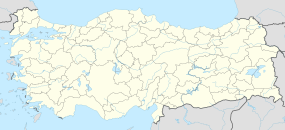
Alexandria Troas is the site of an ancient Greek city situated on the Aegean Sea near the northern tip of Turkey's western coast, the area known historically as Troad, a little south of Tenedos. It is located southeast of modern Dalyan, a village in the Ezine district of Çanakkale Province. The site sprawls over an estimated 400 hectares ; among the few structures remaining today are a ruined bath, an odeon, a theatre, gymnasium complex and a recently uncovered stadion. The circuit of the old walls can still be traced.
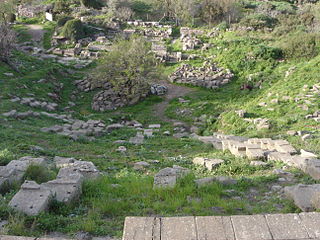
Erythrae or Erythrai later Lythri(Λυθρί, turk. Ildırı) was one of the twelve Ionian cities of Asia Minor, situated 22 km north-east of the port of Cyssus, on a small peninsula stretching into the Bay of Erythrae, at an equal distance from the mountains Mimas and Corycus, and directly opposite the island of Chios. It is recorded that excellent wine was produced in the peninsula. Erythrae was notable for being the seat of the Erythraean Sibyl. The ruins of the city are found north of the town Ildırı in the Çeşme district of İzmir Province, Turkey.

Cleanthes, of Assos, was a Greek Stoic philosopher and boxer who was the successor to Zeno of Citium as the second head (scholarch) of the Stoic school in Athens. Originally a boxer, he came to Athens where he took up philosophy, listening to Zeno's lectures. He supported himself by working as a water-carrier at night. After the death of Zeno, c. 262 BC, he became the head of the school, a post he held for the next 32 years. Cleanthes successfully preserved and developed Zeno's doctrines. He originated new ideas in Stoic physics, and developed Stoicism in accordance with the principles of materialism and pantheism. Among the fragments of Cleanthes' writings which have come down to us, the largest is a Hymn to Zeus. His pupil was Chrysippus who became one of the most important Stoic thinkers.
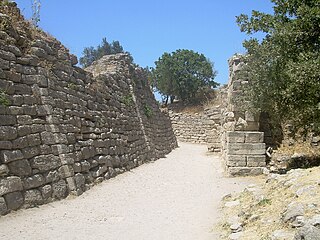
The Troad or Troas is a historical region in northwestern Anatolia. It corresponds with the Biga Peninsula in the Çanakkale province of modern Turkey. Bounded by the Dardanelles to the northwest, by the Aegean Sea to the west and separated from the rest of Anatolia by the massif that forms Mount Ida, the Troad is drained by two main rivers, the Scamander (Karamenderes) and the Simois, which join at the area containing the ruins of Troy.

Cape Baba or Cape Lecton is the westernmost point of the Turkish mainland, making it the westernmost point of Asia. It is located at the village of Babakale, Ayvacık, Çanakkale, in the historical area of the Troad. There was a lighthouse at Cape Baba that was called Lekton in classical times, anglicised as Cape Lecture.
Cebrene, also spelled Cebren, was an ancient Greek city in the middle Skamander valley in the Troad region of Anatolia. According to some scholars, the city's name was changed to Antiocheia in the Troad for a period during the 3rd century BCE. Its archaeological remains have been located on Çal Dağ in the forested foothills of Mount Ida, approximately 7 km to the south of the course of the Skamander. The site was first identified by the English amateur archaeologist Frank Calvert in 1860.
Gargara was an ancient Greek city on the southern coast of the Troad region of Anatolia. It was initially located beneath Mount Gargaron, one of the three peaks of Mount Ida, today known as Koca Kaya. At some point in the 4th century BCE the settlement moved approximately 5.8 km south of Koca Kaya to a site on the small coastal plain near the modern villages of Arıklı and Nusratlı, at which point the previous site came to be known as Old Gargara. Both sites are located in the Ayvacık district of Çanakkale Province in Turkey.
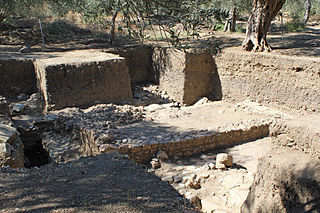
Antandrus or Antandros was an ancient Greek city on the north side of the Gulf of Adramyttium in the Troad region of Anatolia. Its surrounding territory was known in Greek as Ἀντανδρία (Antandria), and included the towns of Aspaneus on the coast and Astyra to the east. It has been located on Devren hill between the modern village of Avcılar and the town of Altınoluk in the Edremit district of Balıkesir Province, Turkey.

Atarneus, also known as Atarna (Ἄταρνα) and Atarneites (Ἀταρνείτης), was an ancient Greek city in the region of Aeolis, Asia Minor. It lies on the mainland opposite the island of Lesbos. It was on the road from Adramyttium to the plain of the Caicus. Its territory was called the Atarneitis.
Hermias of Atarneus was a Greek tyrant of Atarneus, and Aristotle's father-in-law.
The following outline is provided as an overview of and topical guide to classical studies:

Prusias ad Hypium was a city in ancient Bithynia, and afterwards in the late Roman province of Honorias. In the 4th century it became a bishopric that was a suffragan of Claudiopolis in Honoriade. Before its conquest by King Prusias I of Bithynia, it was named Cierus or Kieros and belonged to the Heraclea Pontica. Photius writes that it was called Kieros, after the river which flows by it.

Kition was an Ancient Greek city-kingdom on the southern coast of Cyprus, one of the Ten city-kingdoms of Cyprus.

Hamaxitus was an ancient Greek city in the south-west of the Troad region of Anatolia which was considered to mark the boundary between the Troad and Aeolis. Its surrounding territory was known in Greek as Ἁμαξιτία (Hamaxitia), and included the temple of Apollo Smintheus, the salt pans at Tragasai, and the Satnioeis river. It was probably an Aeolian colony. It has been located on a rise called Beşiktepe near the village of Gülpınar in the Ayvacık district of Çanakkale Province, Turkey.
Larissa, was an ancient Greek city in the south-west of the Troad region of Anatolia. Its surrounding territory was known in Greek as the Λαρισσαῖα (Larissaia). It has been located on a small rise by the coast now known as Limantepe, about 3.5 km from the village of Kösedere to the north-east and 3 km from the village of Babadere to the east, in the Ayvacık district of Çanakkale province, Turkey. As with other Greek toponyms containing the consonantal string -ss-, spellings that drop one 's' exist alongside those that retain both in the ancient literary sources. Larisa in the Troad should not be confused with 'Aeolian' Larissa, near Menemen, or with 'Ionian' Larissa in İzmir province.
Kolonai was an ancient Greek city in the south-west of the Troad region of Anatolia. It has been located on a hill by the coast known as Beşiktepe, about equidistant between Larisa to the south and Alexandreia Troas to the north. It is 3.3 km east of the modern village of Alemşah in the Ezine district of Çanakkale Province, Turkey. Its name in Ancient Greek is the plural form of κολώνη (kolōnē), 'hill, mound', a common name for promontories with hills on them in the Eastern Mediterranean. It is not to be confused with Lampsacene Kolonai, a settlement situated in the hills above Lampsacus in the north-east of the Troad.
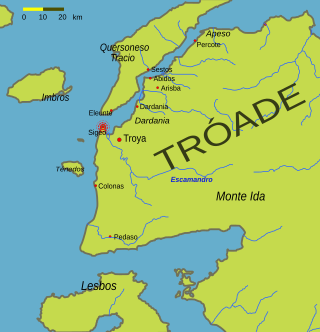
Sigeion was an ancient Greek city in the north-west of the Troad region of Anatolia located at the mouth of the Scamander. Sigeion commanded a ridge between the Aegean Sea and the Scamander which is now known as Yenişehir and is a part of the Çanakkale district in Çanakkale province, Turkey. The surrounding region was referred to as the Sigean Promonotory, which was frequently used as a point of reference by ancient geographers since it marked the mouth of the Hellespont. The outline of this promontory is no longer visible due to the alluvial activity of the Karamenderes which has filled in the embayment east of Yenişehir. The name 'Sigeion' means 'silent place' and is derived from Ancient Greek σιγή (sigē), 'silence'; in Classical Antiquity, the name was assumed to be antiphrastic, i.e. indicating a characteristic of the place contrary to reality, since the seas in this region are known for their fierce storms.
Neandreia, Neandrium or Neandrion (Νεάνδριον), also known as Neandrus or Neandros (Νέανδρος), was a Greek city in the south-west of the Troad region of Anatolia. Its site has been located on Çığrı Dağ, about 9 km east of the remains of the ancient city of Alexandria Troas in the Ezine district of Çanakkale province, Turkey. The site was first identified as Neandreia by Frank Calvert in 1865 and Joseph Thacher Clarke in 1886 and was first excavated by the German architect Robert Koldewey when he excavated in 1889.
Lamponeia or Lamponia (Λαμπωνία), also known as Lamponium or Lamponion (Λαμπώνιον), was an Aeolian city on the southern coast of the Troad region of Anatolia. Its archaeological remains have been located above the village of Kozlu in the district of Ayvacık in Çanakkale Province in Turkey. The site was first visited by Platon de Tchiatcheff in 1849, and later surveyed and identified as Lamponeia by Joseph Thacher Clarke, the excavator of nearby Assos, in 1882, and by Walther Judeich in 1896.

Ancient Greek art stands out among that of other ancient cultures for its development of naturalistic but idealized depictions of the human body, in which largely nude male figures were generally the focus of innovation. The rate of stylistic development between about 750 and 300 BC was remarkable by ancient standards, and in surviving works is best seen in sculpture. There were important innovations in painting, which have to be essentially reconstructed due to the lack of original survivals of quality, other than the distinct field of painted pottery.



